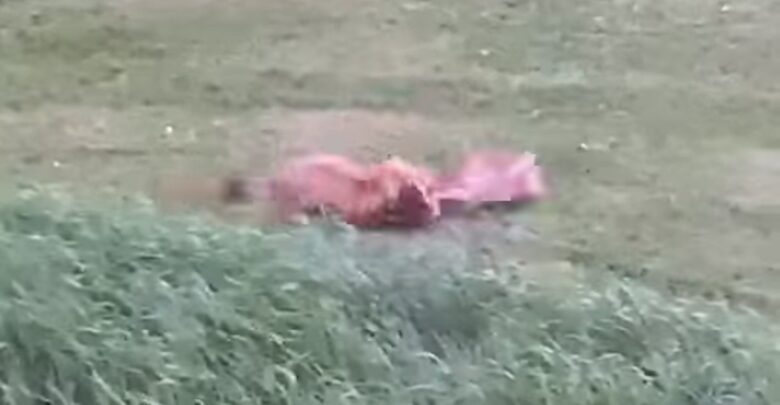
A man films a fox taking down fawn in his backyard. The man intervenes by shouting and knocking violently to scare off the fox, eventually saving the young fawn. A few minutes later, the fawn gets back on its limbs and heads off with its mother.
You can watch the scene of a fox slowly approaching the fawn, which was hidden in some tall grass, filmed by Michigan, a man in Imlay City, from the window of his house. The film has this scene of a fox pouncing over a fawn and pinning it down.
While it is an undeniable fact that predation is a part of the food web, sometimes a little variation in predation is necessary to keep the balance of the ecosystem, like in this episode from Carnivore TV, where a fox attacks a helpless fawn, but the people control the predator and save the little fawn.
Natural Predation Patterns of Foxes
While the fox and the fawn predation may look common, it is actually quite rare. It is observed that foxes always go for smaller prey, such as birds and rodents, but when their food sources are scarce, they might resort to larger animals. Fawns are the only prey large enough to be attacked by a fox, but foxes are not always successful in predating these larger animals due to their size and strength.
It is crucial to remember that predator control should only be utilized in dire circumstances when the ecosystem’s balance is at stake. Nature typically finds a way to regulate itself without help from humans. Respecting nature means letting animals live and grow in their native surroundings without interfering unless it is vitally important.
The significance of predator-prey relationships in maintaining a balanced ecosystem
The maintenance of a balanced ecosystem is an important element in our area of expertise. We can act wisely and compassionately to make a significant impact on the world around us. The predator-prey relationship is a crucial ingredient of balance; predator control helps in the regulation of animal populations and prevents overpopulation of certain species, which might have a cascading effect on the environment and can be one of the major factors in the extinction of another species. For example, a higher number of deer in a particular area may eradicate the vegetation, which can result in soil erosion and the loss of habitat for another species.
Adapting to Predators and Thriving in the Wild
For all species to survive, the delicate balance of our planet’s ecosystems is essential. To maintain this equilibrium, it is crucial to understand the nature and instincts of animals, including fawns. The fawn’s reaction to a predator like the fox is intuitive. It freezes in an effort to disappear into the background and prevent being noticed. If captured, it can try to flee using its speed and agility or hide using its camouflage.
At the moment when a fox is taking down a fawn, the fawn must recover faster to stay out of additional danger. Amazing survival skills in young animals enable them to acclimate to hazards in their surroundings. From their mistakes, they learn how to escape danger by huddling up to their moms or hiding in secure locations.
Additional resources for further reading
1) “The Serengeti Rules” by Sean B. Carroll: This book explores the fundamental principles of ecology and the intricate balance between predators and prey in different ecosystems.
2) “Nature’s Best Hope: A New Approach to Conservation That Starts in Your Yard” is a book by Douglas W. Tallamy. This book highlights the importance of creating wildlife-friendly habitats in our own yards and how it contributes to local wildlife conservation efforts.
3) “Planet Earth II” (TV Series): This acclaimed documentary series, narrated by Sir David Attenborough, features stunning footage of various predator-prey relationships and showcases the intricate dynamics of ecosystems around the world.
4) “The Hunt” (TV Series): Using magnificent footage of animal interactions, this documentary series delves deeply into the tactics and strategies used by predators in their fight for survival.
5) CarbonTV: The CarbonTV website and its popular shows provide a lot of information about predator-prey interactions, backyard animal encounters, and wildlife conservation. They offer a variety of topics for their podcasts, films, and live cams.
6) “Backyard Wilderness” (Film): This immersive movie transports viewers to suburban backyards and showcases the astounding biodiversity and wildlife interactions that can be found in ostensibly commonplace locations.
7) “The Hunted” (Film): is a documentary film that explores the predator-prey relationships in the animal kingdom and exhibits strategies used by both prey and predator for their survival in the wild.
8) “Nature” (TV Series): is a long-running PBS series featuring episodes that explore the various elements of wildlife, including predator-prey dynamics, efforts for conservation, and striking animal behaviors.
_________________________________________________
For more information and to explore our content, visit our website at https://www.carbontv.com.
For more exciting outdoor content and updates, make sure to visit our blog at https://blog.carbontv.com.
_________________________________________________
Explore CarbonTV
Live Cams | Live TV | Shows | Films | Podcasts | CarbonTV Outfitter Services | Firearm Safety | Store
Follow CarbonTV on Social Media:


great vidios.